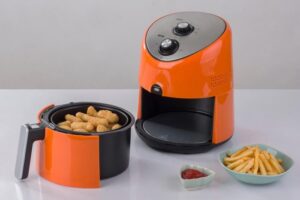Mistakes Everyone Makes with Their Air Fryer
Written by Lola Narawa on March 3, 2022

It might be small—and mighty—but air fryers need their space. That’s because these mini convection ovens rely on a constant flow of air to move the high-temp heat around the food for all-over crispness. Make sure your air fryer has at least five inches of space on all sides, The Kitchn says. And keep it on a stable surface, too, so the vibration won’t send it tumbling onto the floor.
You use too much oil
Most Airfryers call for only a teaspoon or two of oil. If you dump in too much, you’ll get regrettable results. “An air fryer is not a deep fryer,” says Jim Mumford, recipe writer and blogger at Jimcooksfoodgood.com. “I’ve seen people dump two quarts of oil into an air fryer and wonder why their food didn’t work. An air fryer moves very hot air around your food as it bakes, aka a mini convection oven.”
An air fryer’s moving air means light foods could float. “A common mistake I see, that I have done myself, is forgetting that things fly around in the air fryer,” says Anand Bhatt, author of Rockstar recipes. “So something lightweight like spinach, as it starts to fry, ends up getting up in the heating coil—and then it burns, setting off the smoke alarm.
You don’t preheat the air fryer
An air fryer is like an oven: It needs to be hot so it can properly cook whatever you put in it from the moment the door shuts. If it’s too cold, the final food may suffer. Check your recipe’s suggested temperature when you begin pulling out ingredients for cooking. Go ahead and turn the air fryer on so it can be plenty hot when you’re ready to use it. It won’t take long—that small space can reach the right temperature in under five minutes, which makes it great for weeknight cooking.
The foods are too wet
Deep fryers can expel moisture from foods like batters, but an air fryer isn’t capable of that, Mumford says. “Don’t put in limp, wet veggies and expect a miracle. Instead, an air fryer should be used to quickly crisp up already breaded or crunchy foods,” he says. “Think breaded chicken tenders or Brussels sprouts.”
You don’t check the food’s temperature
Don’t neglect your food safety know-how when you turn on an air fryer. The rules of cooking meat thoroughly apply here just as they would on a grill, oven, or stove surface. “Those who think that there is no need to check the internal temperatures when food is air-fried are serving up a recipe for disaster,” Zona-Mendola says. “You want to make sure that you are practicing the same sanitary precautions, as well as cooking temp precautions, as you would with any other method of cooking.”
You put too much food in the basket
The machine needs air around it, and the food does, too. If you overcrowd the basket in your air fryer, your food won’t have a lot of exposed surface area. Where the hot air meets the surface of the food and any oil is where the cooking (and flavour) happens. Because air fryers cook quickly, you can cook in small batches—and that will ensure each piece has the best flavour and texture possible, Cooking Light says. If you loathe the multi-batch approach, look for a larger air fryer. Cooking for a crowd may still require some batch cooking, but for a family of four, it’ll be plenty of space for a weeknight round of crisp cauliflower or broccoli.
You let fatty foods drip
You might have purchased an air fryer to complement a lower-fat eating plan, but you can also use the quick-cooking appliance to fry up favourite high-fat options like burgers, sausages, and even bacon. Before you hit the start button, make sure you put water in the bottom of the cavity under the frying basket. This way, when the fat drips onto the hot surface, it will hit the water—not hot metal, where it will burn, smoke, and smell
Just a few tips to ensure that you’re using that Airfryer correctly.





